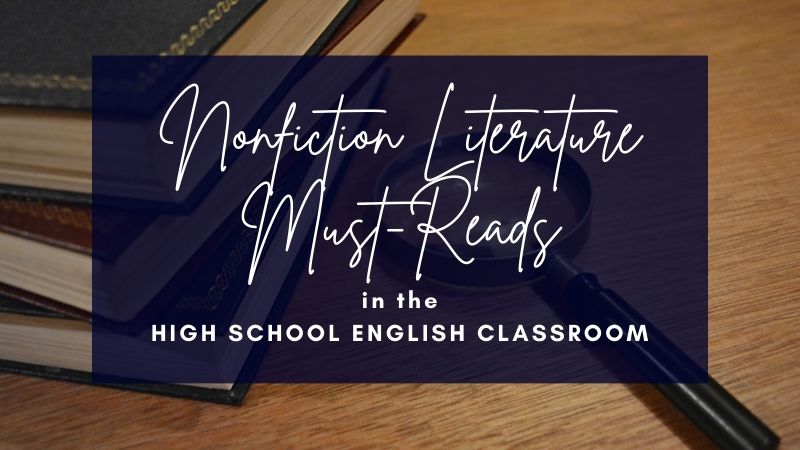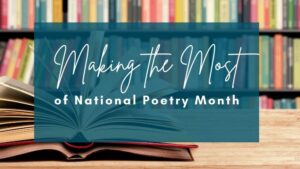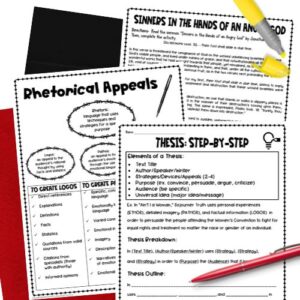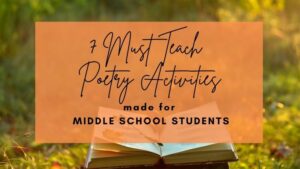English teachers love a good work of fiction; we find many ways to include such works in our classrooms. Where we might need a bit more guidance or support is with the inclusion of more nonfiction literature in our lessons.
With nonfiction, students can use many of the same skills they do with fiction, but nonfiction lit offers some additional options and benefits.
Through its focus on historical or current events, nonfiction literature provides background knowledge that will be useful as students continue in school and beyond. It also provides opportunities for critical thinking and connection-making between texts.
Finally, nonfiction literature teaches students about the ‘real world’ that can widen their understanding and point of view!
Need help with Test Prep? Check out this FREE Pack of 3 Test Prep Activities to help students achieve success on standardized tests!
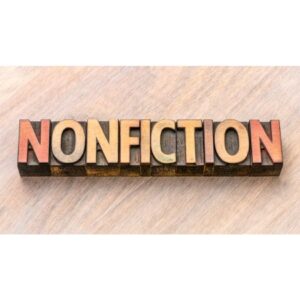
Nonfiction Literature Definition
Nonfiction includes any text based on facts and real events about real people while fiction tells made-up stories even though it might adapt or adopt elements from real life.
Types of nonfiction text stretch far and wide! From biographies, memoirs, or personal essays to textbooks for science, history, and geography, to any true account of current or historical events in newspapers or diaries, through to letters, reviews, and advertisements.
Want help with teaching poetry in April? Check out “Making the most of National Poetry Month!”
12 Nonfiction Literature Examples
1. Speeches
Focusing on the spoken word and referencing written forms, speeches fit into the realm of nonfiction literature. A good speech shares a person’s point; a great speech does that but with flair using rhetorical devices and figurative language to engage the audience! Teaching different speeches is important because speeches teach a lesson in getting an audience to care about a subject. Speeches additionally provide a closer look at rhetorical and figurative language in action.
Examples:
- Sojourner Truth’s “Ain’t a Woman” – Delivered in 1851 at the Women’s Rights Convention in Ohio, this speech focused on equality for race and gender. As an abolitionist and women’s rights activist, Truth’s speech is a must-read with your students! Begin your study of the speech with this series of quiz questions focused on comprehension using Common Core standards-aligned questions.
- “Declaration of Sentiments”- This 1848 speech from the first women’s rights convention is so named for its similarities to the US Declaration of Independence. This speech is a great one because it focuses on examining the author’s purpose of rhetorical devices like repetition, imagery, parallelism, historical allusion, and religious allusion. Grab this ready-made resource to examine all of these aspects!
2. TED Talks™
Extend from historic speeches to more current incarnations with TED Talks™. They offer dynamic and diverse topics and speakers. At Ted.com you can search based on topic, duration, and popularity or check out what is trending based on months of significance or current events. What an easy way to include more Nonfiction Literature!
3. Essays/Research Papers
Secondary sources such as essays and research papers take a deeper dive into a subject and usually do so with a more narrowed focus. One option is to search Google Scholar for scholarly publications relevant to a topic you’re studying in class. Google Scholar includes a wide variety of disciplines and you can usually find a PDF version of the source ready to download.
4. Narratives
Nonfiction literature narratives include memoirs, personal essays, and literary journalism. The stories told remain grounded in facts but include more literary elements to tell a gripping story.
Here are some nonfiction literature narrative ideas with contemporary and/or historical elements:
-
- “Hardware” by Kristin Menke – This personal essay is about a father who owned a hardware store and some of the people and situations he encountered; it is told from the perspective of the subject’s daughter. This original nonfiction narrative is an ideal jumping-off point for examining content and style. Check out this digital and printable resource with a detailed lesson plan, a variety of reading activities, and a full answer key.
- Other narratives like Mark Twain’s semi-autobiographical travel narrative “Roughing It” work as a way to examine different genres. Such narratives are also good for lessons focused on skill development such as inference skills, summarizing, or citing evidence like in this no-prep lesson.
- Jack London’s “The Road” is an autobiographical narrative about the author’s experiences as a wanderer at the end of the 19th century. Like Twain’s text, this one also works for a skill development lesson, this time with a focus on the author’s purpose using an excerpt from this narrative.

5. Autobiographies and Biographies
Accounts of others’ lives written by a third party in the case of biographies or by the subject (him/herself) in the case of autobiographies offer unparalleled insight into notable topics and time periods. Peeking into others people’s lives is not only exciting but highly informative since these texts offer a closer look into a person or moment.
If you want to integrate some science and history in your ELA class, consider an excerpt about Isaac Newton. Gaining insight into the mathematician and physicist renowned for discovering gravity is sure to pique students’ curiosity and provides a cross-curricular connection, too. Use this lesson with a biographical feature of Newton that digs deeper into the structure of such texts.
6. Satire as Nonfiction Literature
The ultimate goal of satire is commentary that is either light-hearted or scathing in order to evoke a change of some sort. Exploring the rhetorical language used in such texts gives students a chance to see how authors play with language to great effect.
Here are 2 prime examples of similar satire:
-
- A Modest Proposal is Jonathan Swift’s (in)famous satirical political pamphlet with a far-fetched solution to famine that is always a hit with students. Check out this rhetorical analysis and reading activities bundle that teachers say is comprehensive and easy to use!
- “Sending Grandma to the Ovens” by Colin Cohen is similar in structure, purpose, and topic to Swift’s piece but just as easily stands on its own. This lesson pack includes standards-based activities, graphic organizers, essay prompts, and everything else you need to teach rhetorical analysis, so your students can write with confidence!
7. Paired Passages
There is an art to using paired passages because you don’t want anything too obvious or too obscure. The goal is to have students ruminate on shared ideas so you want to ensure students can make those connections. Grouping like-texts together is vital because it provides a richer and more engaging learning experience!
For example, the following texts share a theme of fighting to defend the country but are dissimilar in time periods:
-
- FDR’s “Day of Infamy” speech delivered the day after the bombing of Pearl Harbor in 1941 is a major speech in the history of our country as part of the declaration of WWII. Get students to read and analyze the speech with this FREE lesson.
- Then pair FDR’s speech with Patrick Henry’s “Give Me Liberty” speech from a decidedly different time but with a similar message. Compare the use of rhetorical appeals to the audience in each speech. Prep students for this analysis with a series of activities focused on Henry’s speech in this lesson pack.

8. Historical Passages
First-person accounts of historical events provide a window into the past. Unlike biographies or autobiographies, historical passages are often less edited and therefore can provide a better sense of the time. For example, this lesson pack focuses on citing evidence from a passage about the Oregon Trail from Ezra Meeker’s accounts of his travels from Iowa to the Pacific Coast.
9. Important Documents
As the name implies, these nonfiction literature documents are important to the establishment of government, political thinking, and more that reverberate through history up to our current day.
In the United States of America, teaching “The Declaration of Independence” is obviously vital. Students have likely encountered it in other courses so use this familiarity to dig deeper into rhetorical analysis. And make your life easier with this lesson pack that includes everything to teach step-by-step from the reading of the text all the way to the final essay.
10. Sermons/Religious Texts
These types of nonfiction literature texts, like so many of those listed, provide insight into another facet of history. Consider sermons as another genre through which you can analyze rhetoric, structure, and connections to the overarching topic of religion.
One foundational American Literature text is this classic religious text. “Sinners in the Hand of an Angry God” by Jonathan Edwards is an early American sermon awash in rhetoric. Make teaching this nonfiction text stress free with this series of lessons all about Edwards’ historic sermon.
11. News Articles
With a wide variety of digital publications from around the world, news articles are another must-read for high school English. It’s important to know about our world through past and current events because they inform so much of our day-to-day lives. Therefore, make sure to include local, national, and international news sources. News articles are another chance to teach about the realities of different forms of media, a perfect addition to a nonfiction literature unit.
12. Podcasts a Different Type of Nonfiction Literature
Harkening back to the long-gone days of radio, podcasts have made a big comeback in the last decade. And the best part of this comeback is the variety that is available to use in high school English. Whether your students are into science, crime, love stories, current events, politics, or music, you name it and there’s a podcast to fit their interests. With a focus on oral communication, nonfiction literature podcasts provide a different form through which students can complete analysis activities and hone their skills for summary, author’s purpose, and just about everything else!
Need help with teaching poetry? Check out “7 Must Teach Middle School Poetry Activities!”
Why Teach Nonfiction Literature?
Two favorite podcasts include This is Love and Criminal by the same creative team and they are perfect for including more nonfiction literature in your classroom. Episodes in each series are a little off-beat from their key focus on love and crimes. For example, Episode 20 from This is Love tells the story of a man and his guide dog on 9/11. For Criminal, there are stories about witness protection, someone who habitually steals a community statue, police dogs and horses, and more. They are intriguing, relatively short (usually 30 minutes and often less), and just quirky enough to hook students!
Including nonfiction literature in any number of forms is important for student growth. And reading and analyzing different types of nonfiction at all levels of high school creates a framework for growth in background knowledge, comprehension, and skill development.
But incorporating nonfiction texts into high school English classes can seem daunting. Just look at the list of options in this post! However, look at what you currently have as part of your lesson plans and consider where you could add a complementary nonfiction text. If you’re teaching a classic novel, incorporate an excerpt from an author’s biography or think about the big ideas of the novel and find some news articles, a Ted talk, or a speech (historical or contemporary) that can work. You don’t need to reinvent the wheel or suddenly create a whole new unit. Instead, focus on small steps to get more nonfiction literature into your students’ hands.
Need more ideas for English Lesson Plans for Teachers that include Nonfiction Literature? Check out my store Kristin Menke-Integrated ELA Test Prep!

